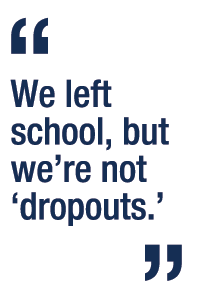America’s Promise Alliance: “Don’t Call Them Dropouts.”
 •
•
“We left school, but we’re not ‘dropouts.’”
An urgent call to better understand why so many youth are leaving high school without their diplomas instead of simply branding them with a negative term is the central message of a new report by Opportunity Nation Steering Committee Member America’s Promise Alliance (APA), Don’t Call Them Dropouts.
These so-called “dropouts” are in fact valuable assets to our society, worthy of our investment and support, the report argues. We agree. As the Opportunity Index demonstrates, the more teens and young adults who are connected to school and work, the more our communities prosper and thrive. So we all have a vested interest in understanding the causes of their disconnection and working with teens and young adults to help them get on a path to success and stability.
 Don’t Call Them Dropouts helps us understand the struggles and the potential of teens and young adults who, for a variety of reasons, have struggled to complete high school. The report highlights their personal stories, in their own words. Only with this fuller picture of why students leave school can we more effectively design solutions to help students graduate and continue on to some form of postsecondary training or education.
Don’t Call Them Dropouts helps us understand the struggles and the potential of teens and young adults who, for a variety of reasons, have struggled to complete high school. The report highlights their personal stories, in their own words. Only with this fuller picture of why students leave school can we more effectively design solutions to help students graduate and continue on to some form of postsecondary training or education.
“ …I started hanging around with the wrong people, gang members getting into crap like…just a lot of stuff. And I don’t want my kids to grow up thinking that it is okay to be doing all that.”
America’s Promise Alliance and Opportunity Nation both believe in the power of youth as assets to our country. We support multiple pathways for them to advance in education and careers. These include credit recovery programs; night and weekend classes; hands-on learning; high-quality guidance and counseling services; and other approaches that help those at risk for dropping out or youth who have recently left school to return and complete their studies.
“I learn really hands-on and if it’s shown to me in a really creative way then I get it right away. But, in traditional high school you sit down and read a book and hopefully you learn this. I just couldn’t do that.”
After months of listening to students, four themes emerged in the report:
- Clusters of factors cause a student to leave school; it’s not a single reason
- Environments are toxic to their learning, such as homelessness, exposure to violence, abuse and being affected by health events in their family
- Yearning for connectedness with others is strong. That can lead towards school or away from it depending on where young people feel they are finding caring bonds
- Resilience, in need of more support and guidance means that these young people are demonstrating day-to-day ability to cope with urgent circumstances and stressors. But they need caring connections to channel their perseverance toward long-term positive development.
At the time they left school, many young people did not see it as giving up, but actually felt they were taking charge of their life, even if they later came to regret the decision. Often these students are caring for sick family members and financially supporting themselves and others.
“I eventually dropped out just ‘cause the bills weren’t getting paid and I knew I could pay the bills, step up. I never took on responsibility like that before in my life.”
It is critical that we understand that these students are motivated. We must tap into their determination and talent, and help them regain a foothold on the path to academic success and economic stability.
After leaving school, many young people have felt locked out of further advancement and want a path forward. We all need to work together – youth and adults; Democrats and Republicans; urban, suburban and rural communities — to find ways to get them back on a path to education and careers. The report reminded us that America is missing out on the talent of these young people and that they are worth investing in.
“I was trying to stay engaged as much as I could but it was like nobody was helping me, nobody.”
The report made five recommendations:
- Listen to young people
- Surround the highest-need young people with extra supports
- Create a cadre of community navigators to help students stay in school
- Follow the evidence
- Empower young people by placing them in central roles designing and implementing solutions that will work for their peers
The research arm of America’s Promise, the Center for Promise at Tufts University, conducted the study with support from Target. The project is intended to help our country better understand why 20% of students are not finishing high school. The GradNation campaign is working towards the national goal of a 90 percent graduation rate by 2020.
See a video of young people sharing their stories and the Don’t Call them Dropouts project blog.









